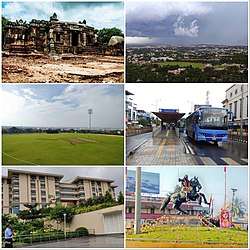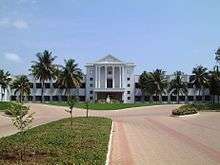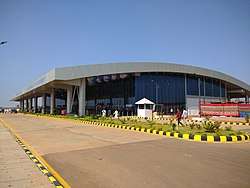Hubli
Hubli, officially known as Hubballi, is a city in the Indian state of Karnataka. It forms a contiguous urban area with the city of Dharwad. Hubli houses the largest number of government offices outside Bengaluru.[1] In 2016, Hubli-Dharwad was selected for solar city / green city master plans.[2] In 2017, government of India included Hubballi-Dharwad city for a smart city project, a flagship scheme for overall development of infrastructure in the twin-cities.[3]
Hubli | |
|---|---|
| Hubballi | |
 Clockwise from Top left; Chandramouleshwara Temple, Hubli Skyline, KSCA Stadium, HD-BRTS, Infosys Hubli, Rani Chennamma Circle | |
 Hubli Location of Hubballi  Hubli Hubli (India) | |
| Coordinates: 15°21′0.78″N 75°08′15.45″E | |
| Country | |
| State | Karnataka |
| Government | |
| • Mayor | Sri Sudhir Saraf |
| Elevation | 671 m (2,201 ft) |
| Population (2011) | |
| • City | 943,857 Hubli-Dharwad |
| • Rank | India : 49 Karnataka : 2 |
| • Metro | 943,857 (Hubli-Dharwad Metropolitan Area) |
| Time zone | UTC+05:30 (IST) |
| Pincode(s) | 580001 - 580064 (incl. Dharwad west end) |
| Area code(s) | +91-0836 |
| Vehicle registration | KA 25 (Navanagar RTO) KA 63 (Gabbur RTO) |
| Official language | Kannada |
| Website | http://www.hdmc.mrc.gov.in |
Etymology
The name Hubballi comes from the term Hoovina Balli which means 'Flowering Creeper' in Kannada. Hubli is the anglicized version of Hubballi.
History
Rayara Hubli, also called 'Eleya Purvada Halli' or 'Purballi', was the old Hubli, where there is a Bhavani Shankara temple and Jain basati. Under Vijayanagara Rayas, Rayara Hubli grew as a commercial centre, famous for trade in cotton, saltpetre and iron. Under the rule of the Adilshahis, the British opened a factory here. The factory was looted by Shivaji in 1673. The Mughals conquered Rayara Hubli and it was then placed under the governance of the Nawab of Savanur, who built a new extension named Majidpura. Later, trader Basappa Shettar built new Hubli around the Durgadabail (fort maidan) part of Rayara Hubli.
Hubli's famous Moorusavira Matha is claimed to have been established by a Sharana of Basaveshwara's period. Hubli was conquered by the Marathas from the Nawab of Savanur in 1755-56. In the following years, Hubli was conquered by Hyder Ali, only to be recaptured by the Marathas in 1790. At this point in time, the old town was administered by a person named Phadke under the Peshwas and the new town was under the administration of the Sangli Patwardhan. The British took Old Hubli from the Peshwas in 1817. The new town, with 47 other villages, was handed over to the British by the Sangli Patwardhan in lieu of subsidy in 1820. Later in 1880, the British started the Railway workshop and with this, Hubli came to be reckoned as an industrial centre in this part of India.[4]
The impressive Chandramauleshwara temple in Unkal is from Chalukyan times. The Sufi shrine, Sayed Fathesha Wali, was visited by Tipu Sultan.[5]
Geography
Climate
Hubli-Dharwad has a tropical wet and dry climate. Summers are hot and dry, lasting from late February to early June. They are followed by the monsoon season, with moderate temperatures and a large amount of precipitation. Temperatures are fairly moderate from late October to early February, with virtually no rainfall. Hubli is 640 meters above sea level. The average yearly rainfall is 838 mm.[6]
| Climate data for Hubli | |||||||||||||
|---|---|---|---|---|---|---|---|---|---|---|---|---|---|
| Month | Jan | Feb | Mar | Apr | May | Jun | Jul | Aug | Sep | Oct | Nov | Dec | Year |
| Average high °C (°F) | 29.1 (84.4) |
31.7 (89.1) |
34.5 (94.1) |
40.0 (104.0) |
38.5 (101.3) |
28.2 (82.8) |
25.9 (78.6) |
25.6 (78.1) |
27.7 (81.9) |
29.2 (84.6) |
28.7 (83.7) |
28.2 (82.8) |
30.6 (87.1) |
| Average low °C (°F) | 14.5 (58.1) |
15.7 (60.3) |
18.6 (65.5) |
27.0 (80.6) |
25.0 (77.0) |
20.9 (69.6) |
20.9 (69.6) |
20.2 (68.4) |
19.6 (67.3) |
18.8 (65.8) |
16.5 (61.7) |
14.3 (57.7) |
19.3 (66.8) |
| Average rainfall mm (inches) | 0 (0) |
0 (0) |
10 (0.4) |
40 (1.6) |
60 (2.4) |
150 (5.9) |
210 (8.3) |
200 (7.9) |
110 (4.3) |
60 (2.4) |
30 (1.2) |
0 (0) |
870 (34.4) |
| Source: [7] | |||||||||||||
Hubli-Dharwad Municipal Corporation
Hubli-Dharwad Municipal Corporation (HDMC) was constituted in 1962 by combining the two cities separated by a distance of 20 kilometres. The area covered by the corporation is spread over 45 revenue villages and is the second-largest city corporation in Karnataka after Bengalooru. The population of the city as per the 1991 census was 700,000. The population of Hubli-Dharwad is 943,857 according to 2011 Census. Hubli Municipal Council was established under the Government of India Act of 1850, and the Dharwad Municipal Council first came into existence on 1 January 1856. Both were merged later.[8][8] The headquarters of HDMC is situated in Hubli, comprising 67 members covering four Vidhan Sabha Constituencies of Hubli-Dharwad.There has been a huge demand by people of Dharwad to create a separate civic body and get itself detached by HDMC.Claims are that most of the funds are allocated to Hubli solely.[9]
Economy
Hubli is one of the commercial hubs of Karnataka. It is the fourth largest city of Karnataka in terms of economy after Bangalore, Mangalore & Mysore. It has a wide cluster of industries and has more than a lakh small and medium industries.[10] The Government of India has set up a Software Technology Park of India on Pune–Bengaluru Road and Aryabhata Tech Park in Navanagar region of Hubli. The city is situated on the dividing line between Malnad and the Deccan plateau. Malnad is well known for its forests and forest-based industries and the other three sides are known for their agricultural products including cotton, groundnut and oil seeds, as well as manganese ore and granite.
The establishment of a new-generation diesel locomotive shed in the city by Indian Railways was another major boost for development of industries in this region, as it was first of its kind in Indian Railways history. The diesel locomotive shed at Hubli is the largest holder of EMD locomotives in India and was set up in 1880.[11]
Demographics
| Population growth of Hubli–Dharwad | |||
|---|---|---|---|
| Census | Population | %± | |
| 1901 | 81,143 | — | |
| 1911 | 91,031 | 12.2% | |
| 1921 | 100,992 | 10.9% | |
| 1931 | 124,398 | 23.2% | |
| 1941 | 143,504 | 15.4% | |
| 1951 | 196,180 | 36.7% | |
| 1961 | 248,489 | 26.7% | |
| 1971 | 379,166 | 52.6% | |
| 1981 | 527,108 | 39.0% | |
| 1991 | 648,298 | 23.0% | |
| 2001 | 786,195 | 21.3% | |
| 2011 | 943,857 | 20.1% | |
| Source: Census of India[12] | |||
| Population Growth of Hubli | |||
|---|---|---|---|
| Census | Population | %± | |
| 1901 | 59,913 | — | |
| 1911 | 61,440 | 2.5% | |
| 1921 | 66,772 | 8.7% | |
| 1931 | 83,494 | 25.0% | |
| 1941 | 95,512 | 14.4% | |
| 1951 | 129,609 | 35.7% | |
| 1961 | 171,326 | 32.2% | |
| 2001 | 533,820 | — | |
| Source: Census of India[12][13] | |||
| Population Growth of Dharwad | |||
|---|---|---|---|
| Census | Population | %± | |
| 1901 | 21,230 | — | |
| 1911 | 29,591 | 39.4% | |
| 1921 | 34,220 | 15.6% | |
| 1931 | 40,904 | 19.5% | |
| 1941 | 47,992 | 17.3% | |
| 1951 | 66,571 | 38.7% | |
| 1961 | 77,163 | 15.9% | |
| 2001 | 252,375 | — | |
| Source: Census of India[12][13] | |||
The population of the twin cities as per provisional figures of Census 2011 is 943,857 and is urban.[14] Hubli-Dharwad's population increased by 22.99% between 1981 and 1991, from 527,108 to 648,298, and by 21.2% between 1991 and 2001. The municipality covers 213 km².
Education

Hubballi, along with Dharwad, its twin city, is an education centre in Karnataka, housing several educational institutions including one of the sixteen IITs and one of twenty five IIITs:
- Dakshina Bharat Hindi Prachar Sabha, Dharwad set up in 1918, institution was recognised by the Indian Government as one of the Institutes of National Importance in 1964
- KLE Technological University, set up in 1947
- Indian Institute of Information Technology, Dharwad, set up in 2015
- Indian Institute of Technology Dharwad, set up in 2017
- Karnatak University, Dharwad, a major university in Karnataka, set up in 1949
- Karnataka Institute of Medical Sciences, Hubballi, set up in 1957; also houses one of the largest hospitals in India
- Karnataka State Law University, Hubballi; all the law colleges in Karnataka are regulated from here
- KLE Institute of Technology, set up in 2008
- Research Center For DNA Diagnostics
- SDM College of Medical Sciences, set up in 2003
- SDM College of Engineering and Technology,Dharwad set up in 1979
- Sri Dharmasthala Manjunatheshwara College of Dental Sciences,Dharwad set up in 1986
- University of Agricultural Sciences, Dharwad, set up in 1986
- AGM Rural Engineering college , varur , Hubballi
- Jain Engineering college , Hubballi
- Karnataka State Forest Academy , Dharwad
- Karnataka Higher education Academy , Dharwad
- Karnataka Balvikas Academy , Dharwad
Transport
Air

Hubli Airport (IATA: HBX, ICAO: VOHB) is a domestic airport serving the twin cities of Hubli and Dharwad and North Karnataka in the state of Karnataka, India. It is situated on Gokul Road, 8 kilometres from city center and 20 kilometres (12 mi) from Dharwad. It is the third busiest airport in Karnataka after Bangalore & Mangalore (both are International Airports), the 45th busiest airport in India. In March 2020, Hubli airport received the best airport award under government of India’s Regional connectivity scheme.[15]Hubli airport Soon gets the International status[16]
Rail

The city currently has four stations and one Junction. The Hubli Junction railway station is the main railway station in the city with a built-up area of 161460 sq.ft.[17] The other stations are Hubballi South, Unkal, Amargol and Navalur. Hubli is the headquarters of the South Western Railway zone. It was carved out as a zone from the current South Central Railway. It is the centre for the Hubli Division. The Hubli Division is one of the highest revenue-generating divisions in India. Hubli is well-connected by the Indian Rail Network. Several express, superfast and Jan Shatabdi trains ply between Hubli and Bangalore every day. Hubli, an important railway junction, has daily trains connecting with major towns across the country.[18] In November 2019, the work for extending a platform was undertaken by the Railways at the estimated cost of 90 Cr. According to railway officials, the length of the renewed platform is estimated at 1,400 meters, which would be longest in the world. The work is scheduled to be completed by the end of 2020.[19]Hubbali Soon to get a Heritage Rail museum. The Indian Railways currently has 11 railway museums across the country.For bringing glory to the proposed Rail Museum, narrow-gauge Railway Rolling Stocks, from different Railways are being displayed and work is moving at a rapid pace. It is proposed to collect photographs of Rail network going back to the 19th and early 20th century so that all old memories of Rail Journey can be part of the photo gallery in the proposed Rail Heritage Museum.[20]
Road
Hubli lies on the "Golden Quadrilateral". Asian Highway 47 passes through Hubli. It lies on National Highway 63 (Ankola - Gooty) and National Highway 218 (Hubli - Humnabad) which connect Hubli with major cities in the region. NWKRTC (North West Karnataka Road Transport Corporation) is a state-run corporation headquartered at Hubli.A semi ring road connecting NH4(Pune - Bangalore), NH67(Ankola - Gooty) and NH218 (Hubli - Humnabad) is already under construction.
Hubli-Dharwad Bus Rapid Transit System


Hubballi-Dharwad BRTS (also known as HDBRTS) is a bus rapid transit system built to serve the twin cities of Hubballi and Dharwad, located in the North-Western part of Karnataka state in India. Hubballi-Dharwad BRTS (HDBRTS) project is a Government of Karnataka initiative to foster long term economic growth in the region. The project promotes fast, safe, comfortable, convenient and affordable public transportation between the twin cities and aims to reduce congestion and air pollution in the region.
The length of the Hubballi-Dharwad BRTS corridor is 22.25 km from CBT Hubballi to CBT–Dharwad with the width of the cross-sections ranging from 44m to 35m. The BRTS corridor includes segregated bus lanes, access-controlled bus stations, physical and fare integration with BRT feeder services, off-board ticketing through smart cards and bar-coded paper tickets, intelligent transport system and high-quality buses (Standard AC buses). The corridor is designed for operating regular and express services. It consists of 2 lanes for BRTS buses on either side of the median bus station facilitating overtaking lanes for express services. Foot overbridges at six locations, PELICAN signals, and synchronized signal management are proposed to facilitate the easy approach of passengers to bus stations.[21]
Notable people
- Gururaj Deshpande, co-founder of Sycamore Networks, the Deshpande Center for Technological Innovation at MIT and the Deshpande Foundation
- Launceston Elliot, weightlifter and gold medallist at the 1896 Olympic Games
- Gangubai Hangal, Hindustani classical vocalist and Padma Vibhushan awardee
- Bhimsen Joshi, Hindustani classical vocalist and Bharat Ratna awardee
- Siddappa Kambli, politician who played an important role in the Karnataka Ekikarna Movement
- Vivek Kulkarni, chairman of Brickwork India and founder MD of Brickwork Ratings
- Rao Sahib Ganpatrao Narayanrao Madiman, businessman and banker
- Sudha Murthy, founder and chairperson of Infosys Foundation
- Nandan Nilekani, co-founder of Infosys
- Vijay Sankeshwar, Chairman and Managing Director of VRL Group
See also
References
- http://www.autocarpro.in/news-national/safexpress-expands-logistics-network-locations-hubli-park-29159
- "Ministry of New and Renewable Energy - Solar / Green Cities". mnre.gov.in. Archived from the original on 14 March 2016. Retrieved 14 March 2016.
- "Constant transfer of MDs, chairpersons hampers execution of Smart City projects in Hubballi-Dharwad | Hubballi News - Times of India". Retrieved 23 June 2020.
- "Hubli | Sightseeing in Hubli | History of Hubli | How to Reach Hubli". Karnataka.com. 15 January 2017. Retrieved 7 February 2018.
- https://www.deccanherald.com/content/478299/dargahs-hubballi.html
- "Archived copy" (PDF). Archived from the original (PDF) on 13 June 2013. Retrieved 13 November 2012.CS1 maint: archived copy as title (link)
- YR
- "Archived copy". Archived from the original on 20 April 2012. Retrieved 13 November 2012.CS1 maint: archived copy as title (link)
- https://timesofindia.indiatimes.com/city/hubballi/demand-to-separate-dharwad-from-hdmc-grows-bigger/articleshow/65545982.cms. Missing or empty
|title=(help) - "'Twin cities emerging as SME hub'". The Times of India.
- http://www.indianrailways.gov.in/railwayboard/uploads/directorate/mec_engg/downloads/DLS/swr/Brief%20history%20of%20the%20shed-UBL.pdf
- "Provisional population totals, Census of India 2011". Archived from the original on 5 April 2020. Retrieved 29 November 2011.
- "HDMC ABOUT TWIN CITY". Archived from the original on 20 April 2012.
- "Census of India 2011 Provisional Population Totals" (PDF).
- "Hubballi Airport bags award under Regional Connectivity Scheme | Hubballi News - Times of India". Retrieved 23 June 2020.
- "HUBBALLI IS BEST CHOICE FOR INTERNATIONAL AIRPORT OF N-KARNATAKA: ANGADI". Hubballi Times. 10 March 2020. Retrieved 23 July 2020.
- BS Reporter (12 September 2012). "Monorail proposed in Hubli-Dharwad".
- "Karnataka's Hubballi to get world's longest railway platform | Cities News,The Indian Express". Retrieved 23 June 2020.
- Sharma, Karun (14 November 2019). "New Rail Heritage Museum coming up at Hubballi". www.thehansindia.com. Retrieved 23 July 2020.
- Hubli-Dharwad Bus Rapid Transit System
External links
| Wikimedia Commons has media related to Hubli. |